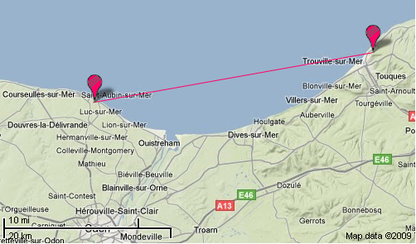This week-end I noticed Juick, an XMPP-based microblogging system with some nice original features. But Juick is not free and its author does not seem interested in freedom. So who’s gonna save XMPP-based microblogging ?
Enter OneSocialWeb, a free, open and decentralized XMPP-based social networking platform with all the federated goodness one might expect from an XMPP-based system. Sounds good doesn’t it ?
Laurent Eschenauer is a software engineer at Vodafone Group R&D and he is the architect of OneSocialWeb – the team also has Alard Weisscher, Lorena Alvarez and Diana Cheng on board. Today he posted great news about OneSocialWeb at Vodafone’s RndBackyard :
“Two months ago, we introduced you to our onesocialweb project: an opensource project that aims at building a free, open, and decentralized social networks. We explained the idea, we showed what it looked like, and we answered many questions. However it was only a prototype running on our servers, there was no such federated social network.. yet.
Today, we have released the source code and compiled versions of the core components of our architecture. With this, you are now in a position to install your own Openfire server, load our Onesocialweb plugin, and you will immediately be part of the Onesocialweb federation. We also provide you with a command line client to interact with other onesocialweb users.
As you see, we are not releasing the web and android client today. They will require a bit more work and you should expect them in the coming weeks. This means that this first release is mainly targeting developers, providing them with the required tools and documentation to start integrating onesocialweb features in their own clients, servers and applications.
This is a first release, not an end product. Our baby has just learned to walk and we’ll now see if it has some legs. We look forward to keep on growing it with the help of the community. Please have a look at our protocol, try to compile the code, and share your feedback with us on our mailing list. You can also have a look at our roadmap to get a feel for where we are going”.
Laurent only mentions Openfire and the OneSocialWeb plugin for Openfire is the only one currently available for download on OneSocialWeb’s site, but despair not if like me you are rather an ejabberd fan : “Its protocol can be used to turn any XMPP server into a full fledged social network, participating in the onesocialweb federation“. So if everything goes well, you may bet on some ejabberd module development happening soon. And who knows what other XMPP servers will end-up with OneSocialWeb extensions.
There were some news about OpenSocialWeb about two month ago, but that was unlucky timing as the project’s message got lost in the Google Buzz media blitz. Anyway, as Daniel Bo mentions : “Many years of discussion have gone into determining what a federated social network would look like, and the OneSocialWeb doesn’t ignore that work“. Indeed, as the OpenSocialWeb mentions, it “has been built upon the shoulders of other initiatives aiming to open up the web and we have been inspired by the visionaries behind them: activitystrea.ms, portablecontacts, OAuth, OpenSocial, FOAF, XRDS, OpenID and more“. Only good stuff there – an open standard built on top of recognized open standards is an excellent sign.
All that just for microblogging ? Isn’t that a slight overkill ? Did we say this was a microblogging protocol ? No – the purpose of OneSocialWeb is much more ambitious : it is to enable free, open, and decentralized social applications. OneSocialWeb is a platform :
“The suite of extensions covers all the usual social networking use cases such as user profiles, relationships, activity streams and third party applications. In addition, it provides support for fine grained access control, realtime notification and collaboration”.
Two weeks ago, Laurent attended DroidCon Belgium and he explained how OneSocialWeb will enable developers to create social & real-time mobile applications, without having to worry about the backend developments:
“In my view, this is one of the most exciting element of our project. Beyond the ‘open’ social network element, what we are building is truly the ‘web as a platform’. An open platform making it simple to create new social applications”.
Here are his slides from DroidCon Belgium :
Is it a threat to Status.net ? No : being an open protocol, it can be used by any system willing to interoperate with other OneSocialWeb systems. @evan has expressed interest about that and I would trust him to hedge his bets. OneSocialWeb certainly competes with Status.net’s ambitious Ostatus distributed status updates protocol, but whichever wins will be a victory for all of us – and I would guess that their open nature and their similar use-cases will let them interoperate well. Some will see fragmentation, but I see increased interest that validates the vision of an open decentralized social web.
By the way, if you have paid attention at the beginning of this article, you certainly have noticed that Laurent’s article was posted at Vodafone’s RndBackyard. Yes, you read it right : OneSocialWeb is an initiative of Vodafone Group Research and Development to help taking concrete steps towards an open social web. Now that’s interesting – are big telecommunications operators finally seeing the light and embracing the open instead of fighting it ? Are they trying to challenge web services operators on their own turf ? My take is that this is a direct attack on large social networking operators whose rising concentration of power is felt as a threat by traditional telecommunications operator who have always lived in the fantasy that they somehow own the customer. Whatever it is, it is mightily interesting – and even more so when you consider Vodafone’s attitude :
“We by no means claim to have all the answers and are very much open to suggestions and feedback. Anyone is invited to join us in making the open social web a reality”.
“We consider it important to reality check our protocol with a reference implementation”.
They are humble, they are open and they are not grabbing power from anyone but walled garden operators : this really seems to be about enabling an open decentralized social. I have such a negative bias about large oligopolistic telecommunications operators that I would have a hard time believing it if I had not had my understanding of the rational behind one of them funding this effort against the likes of Facebook… But free software and open protocols are free software and open protocols – wherever they come from !
Daniel (a.k.a. Daeng) Bo

